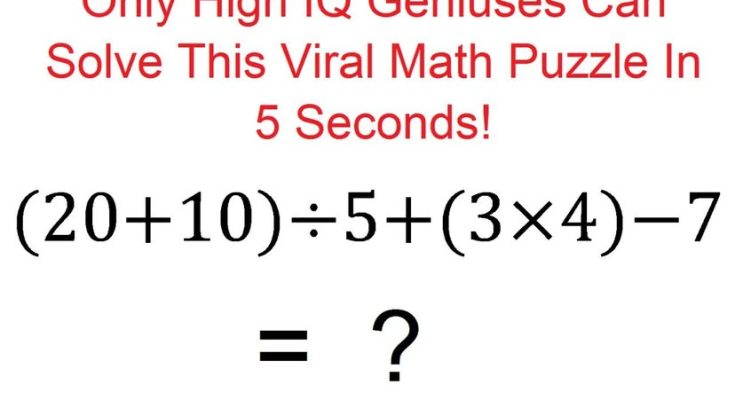1.

2.

3.

4.

5.

6.

7.

8.

9.
Subscribe to Quiz and Puzzle!
Get The LATEST Puzzles and Quizzes to your inbox FOR FREE!
We use your personal data for interest-based advertising, as outlined in our Privacy Notice.

10.

11.

ANSWERS
1. Let’s solve 120 ÷ 5 (20−17) using PEMDAS (Parentheses, Exponents, Multiplication and Division (from left to right), Addition and Subtraction (from left to right)).
Parentheses first:
20 – 17 = 3
So, the expression simplifies to:
120 ÷ 5(3)
Division and Multiplication (left to right):
First, divide:
120 ÷ 5 = 24
Then, multiply by 3:
24 × 3 = 72
Final Answer: 72
2. Let’s solve using PEMDAS (Parentheses, Exponents, Multiplication and Division (from left to right), Addition and Subtraction (from left to right)).
Parentheses first:
(8 + 4) = 12
Now the expression simplifies to:
12 × 3 − 10 ÷ 2
Multiplication and Division (left to right):
First, multiply:
12 × 3 = 36
Then, divide:
10 ÷ 2 = 5
Now the expression simplifies to:
36 – 5 = 31
Final Answer: 31
3. Let’s solve using PEMDAS (Parentheses, Exponents, Multiplication and Division (from left to right), Addition and Subtraction (from left to right)).
Parentheses first:
(5 + 5) = 10
Now the expression simplifies to:
50 ÷ 10 + 6 × 2
Multiplication and Division (left to right):
First, divide:
50 ÷ 10 = 5
Then, multiply:
6 × 2 = 12
Now the expression simplifies to:
5 + 12 = 17
Final Answer: 17
4. Let’s solve using PEMDAS (Parentheses, Exponents, Multiplication and Division (from left to right), Addition and Subtraction (from left to right)).
Parentheses first:
20 + 10 = 30
So, the expression becomes:
30 ÷ 5 + (3 × 4) − 7
Multiplication and Division (left to right):
30 ÷ 5 = 6
3 × 4 = 12
Subscribe to Quiz and Puzzle!
Get The LATEST Puzzles and Quizzes to your inbox FOR FREE!
We use your personal data for interest-based advertising, as outlined in our Privacy Notice.
Now the expression becomes:
6 + 12 – 7
Addition and Subtraction (left to right):
6 + 12 = 18
18 − 7 = 11
Final Answer: 11
5. We observe the difference between consecutive terms:
9 − 5 = 4
17 − 9 = 8
33 − 17 = 16
65 − 33 = 32
The differences follow this sequence: 4, 8, 16, 32
We see that each difference is doubling:
4 = 2^2
8 = 2^3
16 = 2^4
32 = 2^5
The next difference should be 𝟐^𝟔 = 𝟔𝟒
65 + 64 = 129
The next number in the series is 129.
6. Identify the differences between consecutive terms
6 − 5 = 1
9 − 6 = 3
14 − 9 = 5
21 − 14 = 7
The differences form the sequence: 1, 3, 5, 7
The differences follow an increasing odd number sequence: 1, 3, 5, 7, 9
Find the missing number
The next difference should be 9, so:
21 + 9 = 30
Final Answer: 30
7. The given sequence is: 2, 2, 4, 6, 10, 16, ?, is Fibonacci-like way:
1. In the Fibonacci sequence, each term is the sum of the two preceding terms.
2. Here, instead of directly summing the two previous numbers, we observe the pattern:
First two numbers are 2 and 2 (starting values).
Third number = 2 + 2 = 4
Fourth number = 2 + 4 = 6
Fifth number = 4 + 6 = 10
Sixth number = 6 + 10 = 16
Seventh number = 10 + 16 = 26
Thus, the missing number follows the same pattern:
16+10=26
Final Answer: 26
8.
Observing the numbers, we notice:
𝟒 = 𝟐^2
𝟏𝟎𝟎 = 𝟏𝟎^2
𝟑𝟔𝟎𝟎 = 𝟔𝟎^2
𝟏𝟕𝟔𝟒𝟎𝟎 = 𝟒𝟐𝟎^2
Each term follows the pattern:
(𝑃𝑟𝑒𝑣𝑖𝑜𝑢𝑠𝐵𝑎𝑠𝑒)×(𝑆𝑜𝑚𝑒𝐹𝑎𝑐𝑡𝑜𝑟)=𝑁𝑒𝑤𝐵𝑎𝑠𝑒
2 → 10 (multiplied by 5)
10 → 60 (multiplied by 6)


